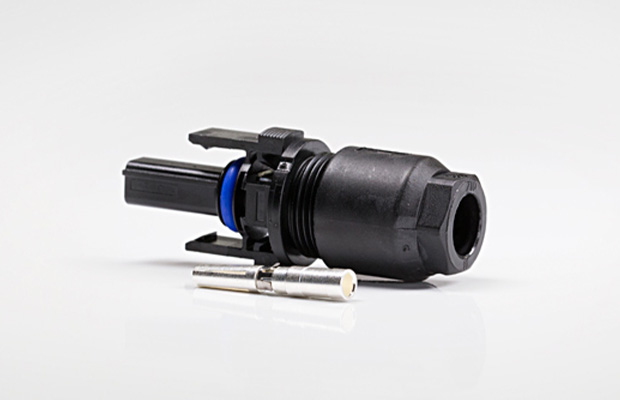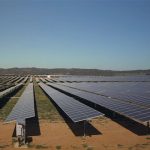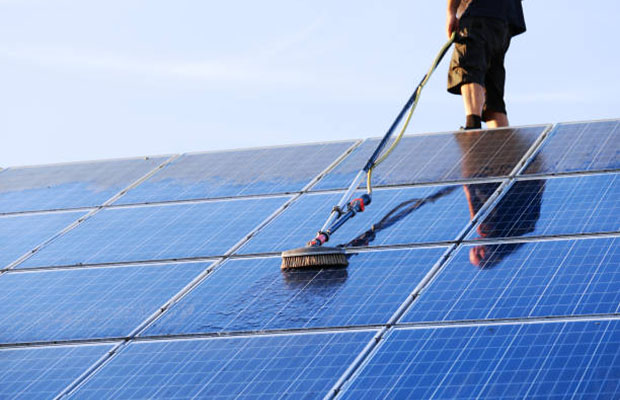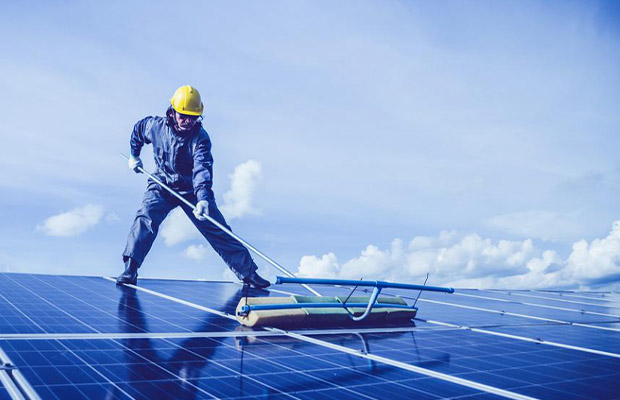Solar panel connectors vary widely from one another. Let’s look at how they differ.
In order to install solar generation systems, solar panel connectors are a necessary component. A typical PV system uses well over 100 connectors.
Any of the connections can cause your system to become unusable if you don’t pay enough attention to these ostensibly minor parts.
Learn how to avoid compliance, warranty, and other problems by reading on.
Table of Contents
What Types of Connectors Are Used for Solar Panels?
Any PV system needs connectors, which are tiny but crucial components. They are used to link solar panels, as their name implies, whether that be to an inverter, another solar panel, or module-level equipment like power optimizers. There are many different types of solar panel connectors, including MC4, T4, and MC3.
Generics, which are frequently interchangeable with a common MC4 connector and simple to spot, are used by some manufacturers. Just scan the datasheet for terms like “MC4 compatible.” An UL-rated connection won’t typically be created by such a combination, which is unfortunate. We’ll go over a few options for handling this later on.
Most Popular Solar Connector Type: MC4
The most common type is unquestionably the MC4 connector. It is now almost universally included with solar panels and module-level technology, including power optimizers and microinverters. These connectors meet the requirements of the National Electric Code and have UL certification.
Multi-Contact, the company’s brand name that came to be associated with the product, is represented by the initials MC. With an IP67 rating, which means they are completely weatherproof, the connectors are made of UV-resistant material.
For increased reliability, MC4 connectors have a locking mechanism that can only be opened with a specific tool. Two connectors, a male and a female, are present on each solar panel. The junction box wires have them at the ends. The first is good, while the second is bad. The female connector is typically fastened to the positive lead. There are, however, some exceptions, so it’s best to look for the markings or run a voltmeter test.
From Leadership to Obsolescence: MC3
The flexible seal that shields MC3 connectors from precipitation makes them weatherproof. To avoid erroneous connections, they are also split into male and female types, similar to MC4.
MC3 connectors were once very common but are now mostly obsolete. The only forces that keep them from disconnecting are friction and suction. The National Electric Code’s requirement for positive locking mechanisms led to the market dominance of MC4 connectors. The MC3 are still simple to find, though. They are used by people for smaller installations or older solar panels that don’t need to comply.
Generic by Canadian Solar: T4 Solar Connector
Tlian, a subsidiary of Canadian Solar, is the manufacturer of T4 connector type. The connectors use a positive locking mechanism and resemble MC4 very much. They have an IP68 rating, which indicates that they are very well protected from rain and dust. They can also boast a very broad operating temperature range, ranging from -40 to 194 degrees Fahrenheit.
These Canadian Solar connectors complied fully with RoHS, REACH, and NEC. A T4 unlocking tool is required to cut the connection. Typically, a pair of those comes with a set of solar connectors, though they can also be bought separately for as little as a few dollars.
Read More: Solar panels for commercial buildings
Are Solar Panel Connectors Universal?
MC3, SolarLok, or other connector types were previously used by PV modules. Homeowners typically had a difficult time choosing panels because of all the available options because they could become confused by the connector or would have to cut the installed connector at the end and crimp their own at the cable with a crimping tool.
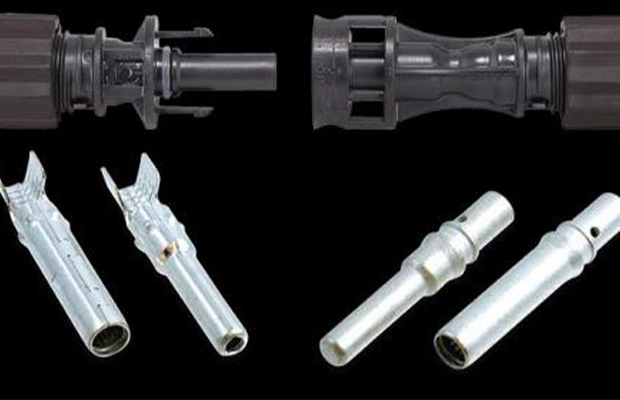
The lack of connectivity was a glaring indication that the solar industry needed to take action to standardize a solar connector for all of the various types of PV modules. Because they were more secure and had a high-quality design, the MC4 connector was eventually established as the industry standard for connecting PV modules and other solar equipment.
No other collector has ever come close to matching the MC4’s excellent performance and high level of security. Since almost all manufacturers use the MC4 connector, it is now thought that solar panel connectors are universal due to the MC4 connector’s widespread use in electronics.
Difference Between MC3 and MC4 Connectors
The MC4 is an improved version of the MC3, which is the wire connector that Multi-Contact created first.
The ingress protection (IP) rating of each connector is what sets them apart from one another. The MC3 has an IP65 rating, which fully shields the cable against dust but only guarantees the protection of the wire against low-pressure water sources. In contrast, the MC4 shields the wire from water immersion and dust particles, making it much safer in bad weather.
The locking mechanism is the second and most significant distinction. If the module is producing energy, the MC3 connector’s lack of protection against wire disconnections makes it easy to disconnect the cable, which could result in an extremely dangerous electric arc in the cable. An MC4 assembly/disassembly tool is required to separate the MC4’s positive locking system.
It turns out that the MC4 connector is a much safer alternative, making it perfect for solar cables of virtually any length at solar generation systems. Simply cut the MC3 connector at the cable’s end, add the MC4 connector by crimping it to the wire with a crimping tool, and replace your old MC3 connectors with some MC4 connectors for each PV module in your house.
Be Careful When Mixing Connectors
The variety of connectors available on the market will be enormous if we include all generic types. Although they are made by different companies, the end user rarely cares how they look or who made them. It matters whether these mixed connections adhere to all applicable regulations, are compatible with other types, and are in compliance with standards.
Almost all solar panels sold today will have solar connectors that abide by all applicable laws. Ask about the type of connectors the panels have if you’re purchasing used modules, though. For example, although MC3 connectors are weatherproof and appear to be fairly reliable, they are not NEC compliant due to the lack of a positive locking mechanism. They cannot, therefore, be used in the majority of states to connect solar panels.
The fusion of various connector types is a further crucial subject. Due to the widespread interoperability of generics with MC4 connectors, compatibility is rarely a problem. The issue is that many of these connections don’t follow all applicable regulations. Nevertheless, some do, such as Canadian Solar’s T4 connector. The business published a document confirming the acceptance of T4 and MC4 connections. In all other circumstances, you have two options: either decide to keep your system’s connectors all of the same type or get in touch with the manufacturer to ask for a warranty addendum and have them replaced.
How To Replace a Solar Panel Connector?
- Remove approximately ½ inch of isolation from the cable tip after carefully removing the old connector, for instance, by cutting it off with a cable cutter.
- There are 4 main components to a connector typically. To take it apart, unscrew the cap.
- Put the wire through the cap after that. Use the cable gland in the same way.
- After inserting the pin into the correct crimping tool slot, feed the cable’s exposed end into the cavity. Press the tool while gently holding it in place to crimp the pin to the wire.
- Screwing them together will now connect the connector’s main component to the rest of it. They ought to converge in the center.
- Tightening the connection will be the final step. To check if the connector is firmly attached to the cable’s end, gently pull on it.
Final Words
When installing solar panels, you can choose any kind of solar connector, but it’s important to consider the connector’s impedance, IP index, and safety locking mechanisms. The best option for any solar installation, including combined or hybrid installations when you power a home with solar panels and wind turbines, the MC4 connector has exceptional specifications in these categories and more.
You can be confident that this is the ideal connector for your PV modules because it has rated parameters of 600V and 22–30 amps for an MC4 connector with a size of 2.5–4.0 mm. Because they can be used in both small solar installations with direct connections and solar farms with long-distance cables and a combiner box, MC4 connectors are ideal in every circumstance.
You May Also Like:
FAQs
Knowing more about solar connectors will help you avoid errors and know how to handle any situation. Here are the most frequently asked questions about solar connectors that we will address.
What Size Wire Can You Use for Each Solar Panel Connector?
The maximum amps that can be sent through each type of solar connector are specific and depend on the wire, inverter, solar charge controller, and solar panel capacity. Although this is occasionally a problem for residential solar installations, you can look up the recommended wire gauge for each connector in the manufacturer datasheet.
The MC4 connector can withstand up to 22 amps for the 2.5 mm² option and 30 amps for the 4.0 – 6.0 mm² connector. For these solar connectors, you may want to look for 14 AWG, 10 AWG, or even 8 AWG cables, depending on the installation requirements.
How Do You Crimp a Solar Connector?
It’s critical to properly crimp each connector to guarantee proper power transfer from the PV modules to the rest of the installation. Crimping a connector refers to fastening the wire into the solar system’s connector.
With the appropriate tool, crimping or assembling a solar connector is fairly simple. To crimp an MC4 connector, you must expose approximately ½ inch of the cable, insert the connector pin into the tool’s corresponding wire gauge cavity, and then firmly hold it in place. Finally, press the crimping tool to securely crimp the MC4 solar connector to the solar cable after inserting the cable by the pin’s opposite end.
An incorrectly crimped connector may be the cause of a solar panel or string of PV modules that appears to be producing less electricity than the others. You can either test the individual performance of each panel in the string before you reconnect them all again, or you can re-crimp the solar connector to fix this issue.
Are Solar Panel Connectors Waterproof?
Connectors for solar panels are protected in terms of an IP index. The index’s first number denotes defense against solid objects, while its second number denotes defense against liquids. The second number is the one you ought to think about in this situation.
An IP67 protection index applies to the MC4 connector. This figure indicates that the connector is protected against immersion for up to 3 feet. of water for up to 30 minutes, any type of pressurized source of water is of course included within this protection index. As long as your MC4 solar connector is submerged in water for no longer than 30 minutes, you can consider it waterproof thanks to this level of protection.
Which Lead is Positive and Which Negative?
The male connector is the negative lead, and the female one is the connector.

